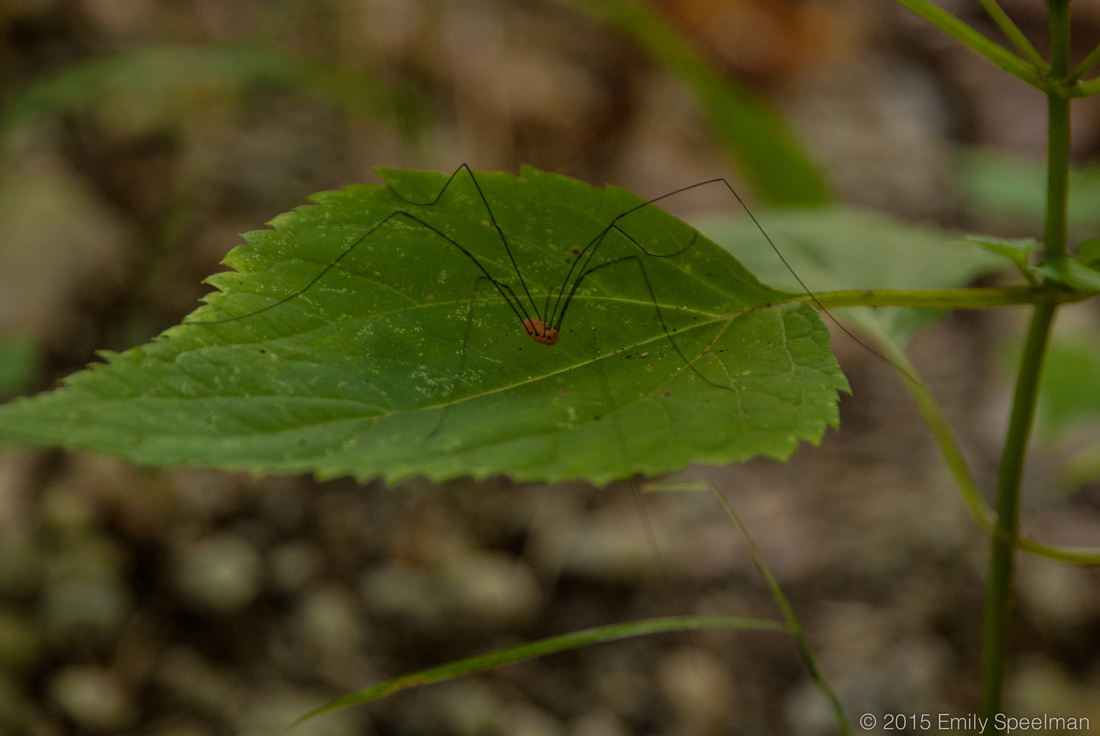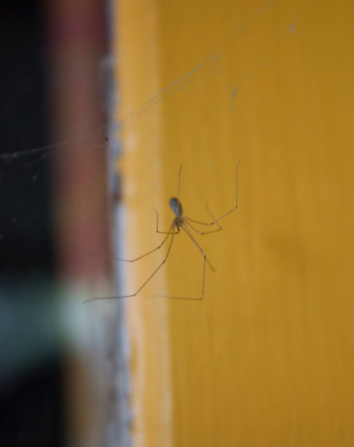|
Growing up in the country I've played with just about every kind of bug imaginable, there was even a time when entomologist was my career path, though I've had my fair share of bites and stings nothing stings me more than the tarnishing of a harmless harvester's reputation. Let me explain. Single segment body - pill shaped, eight looooong legs, climbing on trees, twigs, plants, really anywhere in the woods is where these guys can be found. Growing up we knew these to be 'daddy long legs', giggling as they tickled climbing up our arms. Then the stories came out, "daddy long legs are the most poisonous spider around", "use caution", "their fangs can't break human skin". After that we were hesitant to allow our late friends to climb up our arms, we started looking at them as dangerous creatures. The truth of the matter is, this arachnid isn't even a spider, it's considered a harvestman (Opilione). The most obvious differences between a spider and harvestman are: In harvestmen the connection between the cephalothorax and abdomen is broad so the body appears to be a single oval structure. The Opiliones (harvestman) have no venom glands nor silk glands and therefore don't build webs. Other facts about the harvestman: Their chelicerae are not hollowed fangs but grasping claws that are typically very small and not strong enough to break human skin. They eat "primarily small insects and all kinds of plant material and fungi; some are scavengers, feeding upon dead organisms, bird dung and other fecal material." The other 8 legged friend who has also been called a daddy long legs is the cellar spider (Pholcus Phalangioides) or the skull spider. Named after it's location of residence (cellars, caves, garages) and it's distinctive pattern of the back of it's cephalothorax (resembles a human skull). This spider puts on a big show when a predator gets too close, it vibrates its web creating an almost trampoline like effect startling and scaring off any predators. However, to humans, this spider is harmless. "Like all spiders, cellar spiders are predators. They eat Insecta, Araneae, and other small invertebrates. They spin a large loose, three-dimensional web (not flat like orbweavers) that is not sticky. They use their web as a kind of prey-detection system. When a passing insect bumps into it, they come running out and grab it and bite it, then wrap it in silk. Formicidae are particularly common prey. Many cellar spiders also raid the webs of other spiders, eating their prey and the spiders themselves. They sometimes hunt around the edges of the webs of female spiders of other species. Males who come to mate with the female may get eaten by the cellar spider instead." The cellar spider too is a friend and should be left to live a spider's life cleaning up more dangerous spiders. The third being identified as a daddy long leg is the crane fly which resembles an overgrown mosquito. The thing about the crane fly is when it's in its adult form (while looking like an overgrown mosquito) it doesn't bite nor sting. It spends most of its life as a larvae eating small invertebrate (including mosquito larvae). Let it be known, the daddy long legs are friends to us all!
6 Comments
PC
10/20/2015 12:20:50 pm
Thank you, Emily, once again for the knowledge. We used to hold "daddy long legs" (now I know they are harvestmen) up by one leg and ask "Which way are the cows?" One of the long legs would "point" in a random direction...probably just a reflex...but we thought these spiders had magical powers :)
Reply
5/12/2023 09:26:26 am
Heets satın al heets satın al: https://bit.ly/heets-heets
Reply
8/9/2023 08:19:39 am
Steroid Siparis Steroid Fiyatlari Steroidler Anabolizan Orjinal Steroid Steroid Satis Steroid Satın Al Steroid Siparis Et
Reply
Leave a Reply. |
AboutSince 2015 we have been exploring and sharing all the amazing things we’ve found in nature. AuthorEmily is an Ohio Certified Volunteer Naturalist who is most often found out in the woods. Archives
June 2024
Categories
All
|


 RSS Feed
RSS Feed